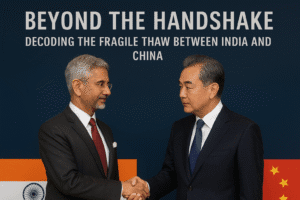Beyond the Handshake: Decoding the Fragile Thaw Between India and China
India and China have taken a cautious step toward easing tensions with a high-level meeting between Foreign Minister S. Jaishankar and China’s Wang Yi in New Delhi, the first since the deadly 2020 Galwan Valley clash that shattered trust and froze ties. This dialogue reflects a recognition of the immense cost of prolonged confrontation—logistical strain, economic setbacks, and global instability. While Jaishankar emphasized de-escalation along the Line of Actual Control (LAC) as essential for progress, Wang offered limited confidence-building gestures like resuming pilgrim access to Tibet.
However, core issues persist, with large troop deployments still in place. Both nations face domestic and strategic pressures to stabilize relations, yet deep mistrust lingers. Genuine progress depends on translating words into verifiable troop withdrawals, managing nationalistic narratives, and sustaining dialogue. For now, this meeting is less a breakthrough and more a fragile thaw—one that must be nurtured carefully to prevent the icy frontier from freezing over again.

Beyond the Handshake: Decoding the Fragile Thaw Between India and China
The image of Indian Foreign Minister S. Jaishankar welcoming China’s Wang Yi in New Delhi this week was more than a diplomatic formality. It signaled a tentative, hard-won shift after five years of deep freeze between Asia’s giants. This meeting, and Wang’s subsequent talks with India’s national security chief and Prime Minister Modi, represents the highest-level political engagement since the deadly 2020 Galwan Valley clash – a stark reminder of the perilous stakes involved.
Why This Meeting Matters Now
This isn’t mere routine diplomacy. The 2020 border clash, resulting in the deaths of 20 Indian and 4 Chinese soldiers, wasn’t just a skirmish; it fundamentally shattered trust. It led to a massive, costly deployment of tens of thousands of troops along the disputed Himalayan frontier, chilling not only political ties but also economic and cultural exchanges. The frost has been persistent.
The meeting suggests both sides recognize the unsustainable cost of perpetual confrontation:
- Strategic Exhaustion: Maintaining massive forces at high altitude is a logistical and financial drain for both militaries.
- Global Instability: As major powers, their friction complicates an already volatile international landscape.
- Economic Pragmatism: While trade exists, full potential remains capped by political distrust. Both nations face domestic economic headwinds, making stability desirable.
- The Shadow of External Factors: Wang’s visit coincides with significant friction between India and the US over steep new tariffs (including penalties linked to Russian oil purchases). While not the primary driver, this context subtly underscores India’s desire for strategic autonomy and the complex balancing act it navigates between major powers.
Reading Between the Diplomatic Lines
The ministers’ public remarks revealed both the cautious hope and the entrenched challenges:
- Jaishankar’s Candor: His call for “deescalation” as the prerequisite for “positive momentum” was direct. He acknowledged the “difficult period” and stressed the need for a “candid and constructive approach.” This reflects India’s core demand: tangible progress on disengagement and de-escalation along the Line of Actual Control (LAC) before broader relations can truly normalize.
- Wang’s Confidence-Building Gesture: Highlighting “peace and tranquility” and the resumption of Indian pilgrim access to Tibet was a deliberate, albeit limited, olive branch. It signals China’s willingness to offer some concessions, likely aiming to shift focus away from the border.
- The Persistent Core Issue: Despite Wang’s assertion of calm, the reality on the ground remains tense with significant troop presences. Jaishankar’s meeting with Wang and NSA Doval’s crucial follow-up discussions explicitly centered on the border dispute. Troop reduction is the unspoken, yet paramount, agenda item.
The Path Ahead: Thaw or Temporary Lull?
This meeting is a necessary step, but far from a breakthrough. It represents a mutual agreement to try talking again, recognizing the dangers of continued stalemate.
Genuine progress hinges on:
- Translating Talks to Troop Movements: Can they agree on credible, verifiable steps to thin out forces in specific friction points beyond previous limited pullbacks? This remains the ultimate test.
- Managing Expectations: Both publics have been fed narratives of national strength. Any significant concession will be domestically sensitive. The diplomacy requires extreme delicacy.
- Sustained Engagement: One meeting won’t resolve years of distrust. Consistent dialogue at diplomatic and military levels is essential.
- Separating Border from Broader Ties: India insists the border situation dictates the overall relationship temperature. China prefers compartmentalization. Bridging this philosophical gap is crucial.
The Human Insight: A Fragile Diplomatic Choreography
This “thaw” isn’t spring; it’s a cautious defrosting of a deeply frozen relationship. The presence of troops along the world’s highest, most inhospitable battlefield is a constant reminder of how quickly things can turn. The meeting in New Delhi is a testament to the grim realization that prolonged confrontation serves neither giant.
The value for readers lies not just in reporting the event, but in understanding its fragility. It’s a story about two proud civilizations, bound by geography and history, wrestling with profound mistrust while acknowledging the immense cost of continued strife. The true measure of success won’t be the warm handshake in New Delhi, but the quiet, unseen movement of soldiers away from a contested, icy frontier in the months to come. The world watches, hoping the ice continues to crack, not refreeze.
You must be logged in to post a comment.